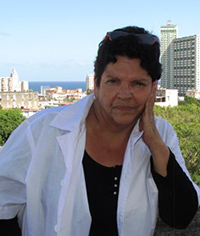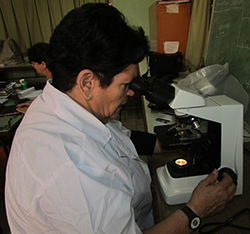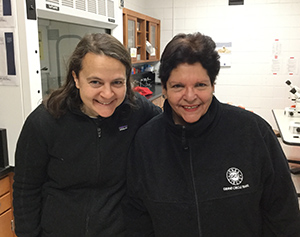Interview with Latin American-Caribbean Short Visit Grant Awardee Ana Sanz Ochotorena
By Marsha Lucas
 Cuban scientist,
Ana Sanz
Ochotorena of the University of Havana, was awarded
the final Latin American-Caribbean Short Visit Grant
by the Society for Developmental Biology. This
discontinued program facilitated travel of Latin
American investigators to laboratories based in the
United States and Canada to learn developmental
biology techniques and approaches that would further
research at their home institution. This past
January, Dr. Sanz spent a month in
Anita Fernandez’
lab at Fairfield University in Connecticut to learn
techniques for identifying genes required during C.
elegans development and characterizing defects
leading to sterility.
Dr. Sanz has been teaching developmental biology at
the University of Havana for 23 years. The Short
Visit Grant was an opportunity for her to get
hands-on experience studying development in a
classical genetic model system and share it with her
colleagues back home. Below is our interview with
Dr. Sanz. Cuban scientist,
Ana Sanz
Ochotorena of the University of Havana, was awarded
the final Latin American-Caribbean Short Visit Grant
by the Society for Developmental Biology. This
discontinued program facilitated travel of Latin
American investigators to laboratories based in the
United States and Canada to learn developmental
biology techniques and approaches that would further
research at their home institution. This past
January, Dr. Sanz spent a month in
Anita Fernandez’
lab at Fairfield University in Connecticut to learn
techniques for identifying genes required during C.
elegans development and characterizing defects
leading to sterility.
Dr. Sanz has been teaching developmental biology at
the University of Havana for 23 years. The Short
Visit Grant was an opportunity for her to get
hands-on experience studying development in a
classical genetic model system and share it with her
colleagues back home. Below is our interview with
Dr. Sanz.
Where did you grow up?
I
grew up in Havana, but I also lived in Varadero Beach
as a child. I have excellent memories of that stage
of my life.
What led you to study biology?
I always loved animals. When I lived in Varadero
Beach, I had an excellent biology teacher during my
secondary studies. Her name was Felicia and she
motivated me a lot.
Where did you do your training?
I received my Bachelor's degree in Biological
Sciences at the University of Havana in 1976, and
then I did technical training in electron microscopy
and experimental embryology at Eotvös Lorandz
University in Budapest, Hungary. In 1989, I got my
Master’s in Molecular and Cellular Biology at
Moscow's Lomonosov University in Russia and I did
another postgraduate study in Embryology there.
Finally, I obtained my PhD in the Faculty of
Sciences of the National Autonomous University of
Mexico in 1999.
 Describe your current research at the
University of Havana. Describe your current research at the
University of Havana.
I have been
researching gametogenesis in endemic animals of Cuba
(amphibians, reptiles) and in invaders using
advanced microscopic techniques. With this, we
intend to elucidate evolutionary and taxonomic
elements of these animals and contribute to their
conservation.
Is it true that you are the only
developmental biologist at the University of Havana?
Are there other developmental biologists on the
island?
It´s true. I work now
with two young people who are aspirants. In Cuba
there are two other universities with a biology
major where developmental biology is taught: at the
Unversidad de Oriente (UO) in Santiago de Cuba and
at the Central University of Las Villas (UCLV) in
Villa Clara. There, I also teach young teachers to
whom I give all possible advice. Of course,
embryology is taught in the Cuban Universities of
Medical Sciences, but not developmental biology.
Why is it important to expand the study of
developmental biology in Cuba?
Because it is a very integrative science that tries
to explain the ontogeny and it has seen
extraordinary growth in the last decades, especially
with the development of molecular biology and
genetics. Current research on stem cells, gene
therapy and patterns of gene expression during
development are essential in this century that has
been called the Century of Biology. By the way, in
Cuba from another point of view there is great
progress in stem cell therapy.
What was the goal of your Short Visit in Dr.
Fernandez’ lab at Fairfield University?
I always had the dream of working with the nematode
C. elegans and I knew of the prestige and
experience of Dr. Fenandez in these topics. So, I
fulfilled my dream.
|
 |
|
Anita Fernandez and Ana Sanz Ochotorena
in the lab at Fairfield University. |
Describe your experience in the Fernandez
lab.
It was excellent from every
point of view. I learned and worked a lot with Dr.
Fernandez, a wonderful person. In addition,
colleagues in the Department of Biology at Fairfield
University were supportive, kind, and affectionate
to me. I am very grateful to the Society for
Developmental Biology, its executives, especially
Ida Chow for giving me this opportunity and to Anita
Fernandez for receiving me and sharing with me her
laboratory, her experiences and her friendship.
What was the most fascinating thing you
learned?
Handling that nematode (C.
elegans) with my hands was astounding. In Cuba
at Havana University we lack equipment and reagents
to perform technical work of this type. So it was
very important for me to work with my own hands in
the laboratory of Anita Fernandez.
If you could be granted three wishes for the
future of developmental biology research in Cuba,
what would they be?
Have a laboratory with the
necessary equipment to develop internships for my
students. In that, my three wishes are summed up.
From there we can start to develop more research.
|